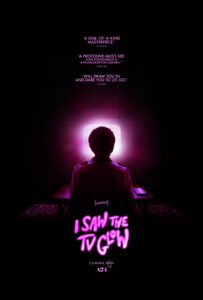Justice Smith and Brigette Lundy-Paine Slay in Darkly Stylized Somnambulistic Descent
DIRECTED BY JANE SCHOENBRUN/2024

“I thought I’d dreamt that”. Surprisingly often, that’s what my older kids have to say when re-introduced to some far-out television show or movie I exposed them to in their younger years. It leads me to consider which shows and films I myself might have filed away as the stuff of childhood fever dreaming. In 2003, Jonathan Caouette’s avant-garde documentary Tarnation gave me one answer. Caouette’s deeply unsettling film utilized footage of the 1970s educational PBS children’s show, “Zoom”. While I never doubted that “Zoom” was real, it was weird how intensely surreal it was to the aged, standard definition footage of kids in bowl cuts and bell bottoms singing and dancing the theme song in a studio of blackened seamless paper and the show’s oversized yellow logo. Out of nowhere, the memory of watching the show while sick came flooding back. Something about the “Zoom” logo reminded me of the melty yellow cheese in a grilled cheese sandwich. When I was sick, a grilled cheese sandwich was the last thing I wanted.
Filmmaker Jane Schoenbrun’s new film I Saw the TV Glow operates fully in that exact difficult-to-pinpoint realm of oneiric unease. Much of it will only ever make sense to Schoenbrun, if that. Which, in this age where overcooked blah I.P. spectacle cinema has been eating everything for years, that is to her creative credit. I guess. Fans of psychologically warped and hopelessly knotty narrative tightrope walks should all be glad that the filmmaker, still quite young and new to the game, has been lucky enough to have fallen in with A24.

I Saw the TV Glow spans decades as it follows the suburban travails of an African-American kid named Owen (primarily portrayed by Justice Smith with Ian Foreman as younger Owen). It begins in the mid-1990s as Owen’s affinity for a TV show called “The Pink Opaque” develops into an obsession. This obsession is fostered by Maddy (Brigette Lundy-Paine), a cooly aloof older girl who’s all in on the show when Owen meets her. Reluctantly, she takes him under her wing in his efforts to simply watch “The Pink Opaque”, as he’s not allowed to do so at home due to its odd airtime. (Limp Bizkit’s Fred Durst is horrifying as Owen’s strict father, who presumably has never bought a VCR for his family). Together, Maddy and Owen bond trepidatiously over the show.
“The Pink Opaque” itself is a bit of a fish-out-of-water program, complex in its supernatural mythology but airing on “The Young Adult Network” (a surrogate of WB Network-turned-CW Network, with a bit of Nickelodeon in the mix). There’s a very strong, very obvious “Buffy the Vampire Slayer” vibe to it, which spills into the film itself with a brief appearance by “Buffy” fan favorite Amber Benson.
Yet, the “Buffy”-ness of it all is largely a distraction. Where that show was a multifaceted and challenging but ultimately life-affirming venture, Owen and Maddy derive no such excitement from “The Pink Opaque.” As though under the spell of its big bad, Mr. Melancholy, their lives maintain a depressive through-line, keeping each other at arm’s length. It’s this somber and depressive quality that dominates and defines the darkly stylized somnambulistic I Saw the TV Glow.

Years pass as Owen and Maddy lose touch and reconnect several times. It becomes apparent that Maddy has devoted her life to pursuing “The Pink Opaque”, even long after it’s canceled. (Were there six seasons or only five…?) In one of the film’s most weird and intriguing bits, she gives a haunting monologue about her immersion into the show. What is real and what isn’t about “The Pink Opaque”? Or, by frightful extension, about their lives? Will Owen follow Maddy on her lucid pathways?
In all of this, it’s pretty clear that Schoenbrun’s motivations lie in David Lynch-ian storytelling and grappling with the melancholy of it all. There’s something effectively experiential about it even as it seems to never truly know what it’s about. For many, the fact that I Saw the TV Glow’s 100-minute runtime somehow feels like three hours is a supernatural dealbreaker in its own right. And there’s definite validity in that viewpoint. But one can’t rule out Smith and Lundy-Paine’s deeply committed leap-of-faith performances amid Schoenbrun’s uncompromising static-riddled bruised grilled-cheese fever dream of a movie.

